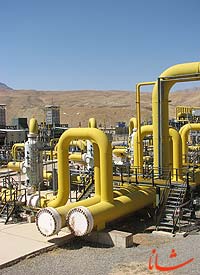As global energy demand rises, natural gas increasingly plays a strategic role. The sector is poised for tremendous growth over the next two decades and some believe that it may overtake oil as the prime fuel between 2020 and 2030.
These impressive reserves figures – second only to the
More than 60 percent of
South Pars was first identified in 1988 and was originally thought to contain just 128 tcf. Current estimates show it to contain at least 280 tcf (with some estimates going as high as 500 tcf) as well as over 17 billion barrels of condensate.
By 2010, more than 500,000 barrels per day of condensates could be produced at South Pars, mainly for domestic consumption. Designed in 28 phases, so far only 18 phases have been activated. By 2015, condensate production from South Pars phases 1-14 is expected to reach 628,000 bpd. Besides condensate production and enhanced oil recovery, South Pars natural gas is intended for both domestic consumption and exports. South Pars can produce more than 400 million cubic meters per day (14.2 billion cubic feet/day). Considering internal demand, half of this production can be assigned to exports.
Internal consumption represents a rapidly growing demand on Iranian gas supply. The NIGC expects internal consumption to rise to 156.2 bcm per year in 2009 (13.2 bcf/day). (Editor’s Note: The National Iranian Oil Company is purported to raise oil production to about 5.4 million barrels per day by 2009.)
Market Expansion
By 2009, NIGC expects to have 29,400 kilometers of gas transmission pipeline in place and a distribution network of 125,000 km. Domestic gas consumption that year will represent 69 percent of the Iranian energy market, and 54 million Iranians will have access to natural gas – about 80 percent of the population.
NIGC plans to invest about $18 billion through 2009 in high-pressure gas pipelines, compressor stations, gas-processing plants, underground storage, distribution networks, and maintenance.
Pipeline Projects
Many of the pipeline projects planned by NIGC will be attached to the Iranian Gas Transmission (IGAT) system. Transmission pipelines with a length of 20,000 km take gas from various sources to destinations across the whole country. Lines with diameters of 56, 48, and 42 inches have been employed to carry more than 500 million cubic meters per day (17.7 bcf/day) of natural gas.
The IGAT IV pipeline will carry 110 (mcm/day) of gas from South Pars and the Parsian gas plants to consumption areas. The project includes 1,030 km of 56-inch pipe in two sections and two compressor stations. Parts of IGAT IV have begun service. The main part of the pipeline was connected with the Pol Kaleh compressor station in
A second stage of IGAT IV will include a 42-inch spur line to
The 56-inch IGAT V trunkline will carry 75 mcm/day of sour gas from South Pars Phases 6-8 to Khoozestan oil fields for injection. It will connect Assaluye and Agha Jari, a distance of 504 km, and will have five compressor stations.
The IGAT VI pipeline will generally parallel IGAT V to serve gas needs of Bushehr and Khoozestan provinces, including oil field injection. With a length of 492 km and a diameter of 56 inches, it will have a capacity of 90 mcm/day. Two compressor stations are planned.
IGAT VII, 860 km of 42 to 56-inch line, will carry gas produced in South Pars Phases 9 and 10 for use in Sistan and Baluchestan provinces in southern
IGAT VIII, a 1,050-km, 56-inch line, will carry South Pars gas to the Parsian gas plant and north to a line serving
To meet growth in gas demand in the northern and eastern provinces of Semnan, Khorasan, Golestan, and Mazandaran, NIGC plans a second pipeline between Parchin and Sangbast, 790 km long with a diameter of 48 inches, and a 110-km, 40-inch segment between
To serve the western and northern provinces of Hamadan, Kordestan, Zanjan, as well as East and West Azerbaijan, NIGC plans to lay 280 km of 48-inch pipeline between a compressor station at Saveh and the city of Bijar, and 192 km of 40-inch pipeline between Bijar and Miandoab. Other segments with diameters of at least 30 inches will boost pipeline lengths planned for this region to 950 km.
Gas Processing Projects
Seven gas processing plants have recently been completed or are planned and under construction in
Construction of the new processing facilities will proceed in two phases, one with an inlet capacity of 48 mcm/day and the other, 28 mcm/day. The complex is designed for annual yields of 85,000 tons of ethane, 11 million barrels of pentanes-plus, 310,000 tons of butane, and 450,000 tons of propane.
The Bidboland II plant will sweeten and process 57 mcm/day of gas at facilities that will be built about 14 km southeast of the existing Bidboland plant. Fed by gas from the Pazanan, Gachsaran, and Bibi Hakimeh fields, the new plant has design output capacities of 15 bcm of sweet gas, 1.48 million tons of ethane, 1.51 million tons of propane and butane, and 860,000 tons of natural gasoline.
About 6 bcm per year from the plant are targeted for oil-field injection, the rest for delivery into the gas grid. Ethane will go to a petrochemical plant at Arvand. The other products will be exported through Bandar Mahshahr.
In a separate project, NIGC plans a gas processing plant 25 km northwest of the city of
NIGC also plans a small processing plant at Masjed Soleiman with inlet capacity of 1 mcm/day and is studying a plant able to process 14 mcm/day at South Gesho sour gas field in


Your Comment